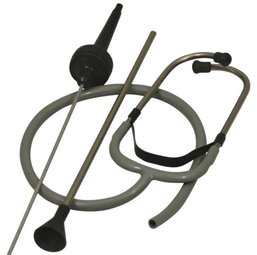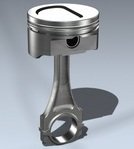Getting Engine Noise Diagnosis Right

Proper engine noise diagnosis is a very important issue to address. In fact improper diagnosis can lead you on a wild goose chase.
This page can help, so give me a chance before you bounce. I added two videos of a real rod knock and a lifter tap at the bottom so you can hear the different sounds they make.
Here’s an example of a big mistake I made. It taught me a valuable lesson that we can all learn from. I had a double knock and believed the engine noise was a wrist pin.
I removed the engine and disassemble it only to find out the camshaft thrust plate loosened up. This allowed the cam to walk up and back. I wasted day’s of work that wasn’t needed.
I was young when this happened, but I still think about it today when I hear motor noises.
Sometimes an engine malfunction will reveal itself first as an unusual noise. This can happen before the problem changes the actual performance of the car.
Some of these problems include badly worn piston rings or ring lands, loose wrist pins, worn main bearings or connecting rod bearings. In addition loose valve train components all produced telltale noises that are unique.
With a little practice a do it yourself auto mechanic can gain the experience and knowledge to interpret what engine noises mean and distinguish them from one another.
This can and will avoid a costly and time-consuming engine tare down. Always take the extra time to make a proper noise analysis before doing any engine repair work. Also having a heads up on the noise can reduce repair costs by addressing the problem before irreversible engine damage occurs.
Diagnosis with a Stethoscope
You can hear some negative engine sounds without using a listening device, but others are impossible to hear and or pinpoint unless amplified.
I still see a lot of auto mechanics performing engine noise diagnosis using the large screwdriver pushed up against the ear method. This is okay for very loud noises, but not for small or developing noises.
Especially since the procedure for using a stethoscope is simple and the tool is cheap. I own the Lisle on the left, but I paid $50 on the brand name tool truck.
Use the tip of the metal probe on the mechanics stethoscope to trace the sound until it reaches its maximum intensity. Once the precise location is found the sound can be better evaluated.
A mechanic’s stethoscope will provide much clearer and accurate results. The newest tools to hit the market are electronic listening devices. This may be overkill for the do it yourself car mechanic.
Nevertheless, with this tool you can tune into the noise and cancel out surrounding noises. This can lead to even more accurate engine noise diagnosis.
Some Common Engine Noises

To follow, I’ll provide some examples of abnormal engine noises. It’s important to point out that insufficient lubrication is the most common cause of an engine noise.
For this reason, you should always check the oil level in the crank case and possibly perform an engine oil pressure test.
One sound that might be heard on an engine with high mileage is a piston slap. This sound is commonly heard when the engine is cold and often gets louder when the vehicle accelerates.
When a piston slaps against a cylinder wall, the sound is like a hollow dull bell type sound. Piston slap is often caused by worn pistons or cylinder walls.
In extreme situations on engines with high mileage you can have collapsed piston skirts and alignment issues with connecting rods. Worn engine rings and excessive blow by are also a sign of this problem.
On the other hand, a wrist pin knock has it’s own unique sound. This sound will be different depending on how many wrist pins are making noise. If all the wrist pins are loose it will produce an overwhelming rattling inside the engine.
This sound is described as a double knock, because it will cause a noise at the top of the piston travel and when the piston changes direction it will make another noise.
This noise is most notable when the engine is idling and the engine is also hot. An engine rod bearing noise is near the top of the most common internal engine noises you’ll hear.
We consider this a lower end knock. A Rod knock is the result of a worn or loose connecting rod bearing. Often it’s caused by poor lubrication or they just wear out on high mileage engines. The noise is heard at idle as well as part throttle conditions.
The severity of the noise depends on how badly the bearings are worn. Noises can range from a light tap to a heavy knock or even a pounding, when the bearing becomes extremely damaged or spun. When it’s at this level, removing the engines oil pan may expose the problem.
The lifter noise is one of the most common complaints I received from customers. Also note that some lifter noise is considered normal from several manufacturers such as General Motors.
The engine lifter noise is characterized by a light regular clicking sound that is more noticeable when the engine is idling. It can be a result of the excessive clearance in the valve train.
A clearance problem can be located by inserting a feeler gauge between each lifter and valve tip. This will differ depending on cam design.
Engine lifter noise can be caused by improper valve adjustment, worn or damaged parts, hydraulic lifters clogged with sludge or lack of oil pressure.
Give this engine noise diagnosis resource page a bookmark or share.
Rod knock engine noise example
Lifter Tap Noise Example
This article discussed some of the most common engine noises that you will run into. There can be other causes and a few different types of sounds. Visit the automotive engines section of this site to learn more about noise diagnosis on auto engines.
Not many people can say they have taken an engine apart before. This is a skill you get better at every time you do it. I started with building a realistic model car engine before attempting the real thing.
When it comes to fixing your own vehicle knowledge is the most important tool. See what I think about modern online car repair manuals.
If you would like to find out what else is covered on this automotive repair website the homepage provides an explanation. You can also learn more about the mechanic that built this website and thinks people can do their own repairs at home with some auto repair help.

